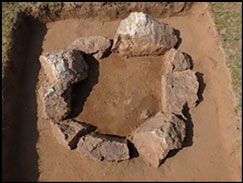Crossref Citations
This article has been cited by the following publications. This list is generated based on data provided by
Crossref.
Lepetz, Sébastien
Zazzo, Antoine
Bernard, Vincent
de Larminat, Solenn
Magail, Jérôme
and
Gantulga, Jamyian-Ombo
2019.
Customs, rites, and sacrifices relating to a mortuary complex in Late Bronze Age Mongolia (Tsatsyn Ereg, Arkhangai).
Anthropozoologica,
Vol. 54,
Issue. 1,
p.
151.
Jeong, Choongwon
Wang, Ke
Wilkin, Shevan
Taylor, William Timothy Treal
Miller, Bryan K.
Bemmann, Jan H.
Stahl, Raphaela
Chiovelli, Chelsea
Knolle, Florian
Ulziibayar, Sodnom
Khatanbaatar, Dorjpurev
Erdenebaatar, Diimaajav
Erdenebat, Ulambayar
Ochir, Ayudai
Ankhsanaa, Ganbold
Vanchigdash, Chuluunkhuu
Ochir, Battuga
Munkhbayar, Chuluunbat
Tumen, Dashzeveg
Kovalev, Alexey
Kradin, Nikolay
Bazarov, Bilikto A.
Miyagashev, Denis A.
Konovalov, Prokopiy B.
Zhambaltarova, Elena
Miller, Alicia Ventresca
Haak, Wolfgang
Schiffels, Stephan
Krause, Johannes
Boivin, Nicole
Erdene, Myagmar
Hendy, Jessica
and
Warinner, Christina
2020.
A Dynamic 6,000-Year Genetic History of Eurasia’s Eastern Steppe.
Cell,
Vol. 183,
Issue. 4,
p.
890.
Lazzerini, Nicolas
Zazzo, Antoine
Coulon, Aurélie
Marchina, Charlotte
Bayarkhuu, Noost
Bernard, Vincent
Cervel, Mathilde
Fiorillo, Denis
Joly, Dominique
Noûs, Camille
Turbat, Tsagaan
and
Lepetz, Sébastien
2020.
Season of death of domestic horses deposited in a ritual complex from Bronze Age Mongolia: Insights from oxygen isotope time-series in tooth enamel.
Journal of Archaeological Science: Reports,
Vol. 32,
Issue. ,
p.
102387.
Taylor, William
Fantoni, Marcello
Marchina, Charlotte
Lepetz, Sébastien
Bayarsaikhan, Jamsranjav
Houle, Jean-Luc
Pham, Victoria
and
Fitzhugh, William
2020.
Horse sacrifice and butchery in Bronze Age Mongolia.
Journal of Archaeological Science: Reports,
Vol. 31,
Issue. ,
p.
102313.
Sadykov, Timur
Caspari, Gino
and
Blochin, Jegor
2020.
Kurgan Tunnug 1—New Data on the Earliest Horizon of Scythian Material Culture.
Journal of Field Archaeology,
Vol. 45,
Issue. 8,
p.
556.
Ponomareva, Irina A.
2020.
Unraveling manifold identities in the early nomadic rock art of East Siberia.
Archaeological Research in Asia,
Vol. 23,
Issue. ,
p.
100208.
Taylor, William
Wang, Juan
and
Hart, Isaac
2020.
Understanding the prehistory of domestic animals in East and Central Asia through scientific archaeozoology.
Journal of Archaeological Science: Reports,
Vol. 32,
Issue. ,
p.
102397.
Rofes, Juan
Cersoy, Sophie
Zazzo, Antoine
Royer, Aurelien
Nicod, Pierre‐Yves
Laroulandie, Veronique
Langlais, Mathieu
Pailler, Yvan
Leandri, Celine
Leandri, Franck
Lebon, Matthieu
and
Tresset, Anne
2020.
Detecting stratigraphical issues using direct radiocarbon dating from small‐mammal remains.
Journal of Quaternary Science,
Vol. 35,
Issue. 4,
p.
505.
Lazzerini, Nicolas
Zazzo, Antoine
Coulon, Aurélie
Turbat, Tsagaan
Marchina, Charlotte
and
Lepetz, Sébastien
2020.
Date of death of domestic caprines assessed by oxygen isotopic analysis of developing molars: Implications for deciphering the calendar of pastoral activities in prehistory.
Journal of Archaeological Science,
Vol. 120,
Issue. ,
p.
105163.
Taylor, William Timothy Treal
Hart, Isaac
Jones, Emily Lena
Brenner-Coltrain, Joan
Thompson Jobe, Jessica
Britt, Brooks B.
McDonald, H. Gregory
Li, Yue
Zhang, Chengrui
Le Roux, Petrus
Shield Chief Gover, Carlton Quinn
Schiavinato, Stéphanie
Orlando, Ludovic
and
Roberts, Patrick
2021.
Interdisciplinary Analysis of the Lehi Horse: Implications for Early Historic Horse Cultures of the North American West.
American Antiquity,
Vol. 86,
Issue. 3,
p.
465.
Wright, Joshua
2021.
Prehistoric Mongolian Archaeology in the Early 21st Century: Developments in the Steppe and Beyond.
Journal of Archaeological Research,
Vol. 29,
Issue. 3,
p.
431.
Esin, Yury
Magail, Jerome
Gantulga, Jamyian-Ombo
and
Yeruul-Erdene, Chimiddorj
2021.
Chariots in the Bronze Age of Central Mongolia based on the materials from the Khoid Tamir river valley.
Archaeological Research in Asia,
Vol. 27,
Issue. ,
p.
100304.
Marciszak, Adrian
Wagner, Jan
Kyselý, René
Matyaszczyk, Lena
Roblíčková, Martina
Plichta, Aleš
and
Káňa, Vlastislav
2022.
THE LATE PLEISTOCENE HISTORY OF THE BROWN BEAR URSUS ARCTOS LINNAEUS, 1758 IN THE CZECH REPUBLIC.
Radiocarbon,
Vol. 64,
Issue. 6,
p.
1483.
Steuri, Noah
Milella, Marco
Martinet, Francesca
Raiteri, Luca
Szidat, Sönke
Lösch, Sandra
and
Hafner, Albert
2023.
FIRST RADIOCARBON DATING OF NEOLITHIC STONE CIST GRAVES FROM THE AOSTA VALLEY (ITALY): INSIGHTS INTO THE CHRONOLOGY AND BURIAL RITES OF THE WESTERN ALPINE REGION.
Radiocarbon,
Vol. 65,
Issue. 2,
p.
521.
Le Neün, Manon
Dufour, Elise
Zazzo, Antoine
Tombret, Olivier
Thil, François
Wheeler, Jane C.
Cucchi, Thomas
and
Goepfert, Nicolas
2023.
Holocene occupation of the Andean highlands: A new radiocarbon chronology for the Telarmachay rockshelter (Central Andes, Peru).
Quaternary Science Reviews,
Vol. 312,
Issue. ,
p.
108146.
Dal Zovo, Cecilia
Parcero-Oubiña, César
César González-García, A.
and
Güimil-Fariña, Alejandro
2023.
Mapping human mobility and analyzing spatial memory: palimpsest landscapes of movement in the Gobi-Altai Mountains, Mongolia.
Journal of Anthropological Archaeology,
Vol. 71,
Issue. ,
p.
101516.
Taylor, William Timothy Treal
Hart, Isaac A
Tuvshinjargal, Tumurbaatar
Bayarsaikhan, Jamsranjav
Jarman, Nicholas L
Bittner, Peter
López Calle, Paula
Blakeslee, Logan A
Zahir, Muhammad
Chauvey, Lorelei
Tressières, Gaëtan
Tonasso-Calvière, Laure
Schiavinato, Stéphanie
Cruaud, Corinne
Aury, Jean-Marc
Oliveira, Pedro H
Wincker, Patrick
and
Orlando, Ludovic
2024.
High altitude horse use and early horse transport in eastern Eurasia: New evidence from melting ice.
The Holocene,





